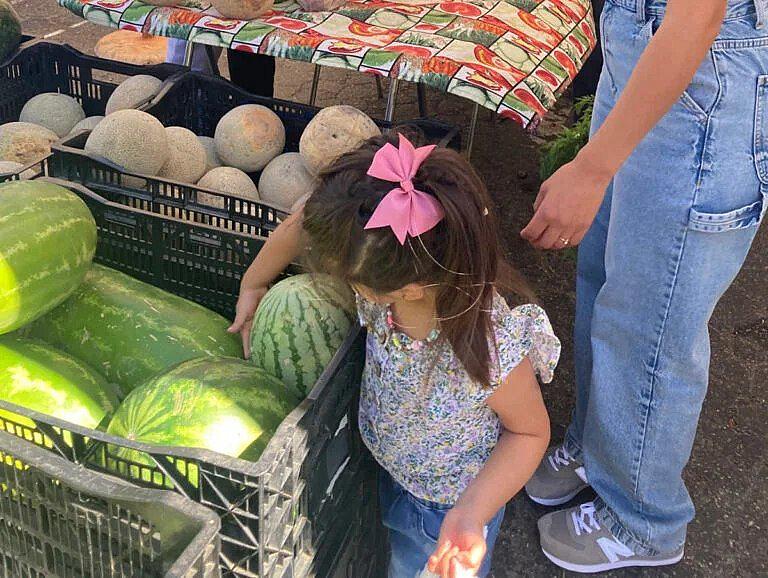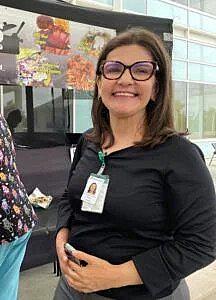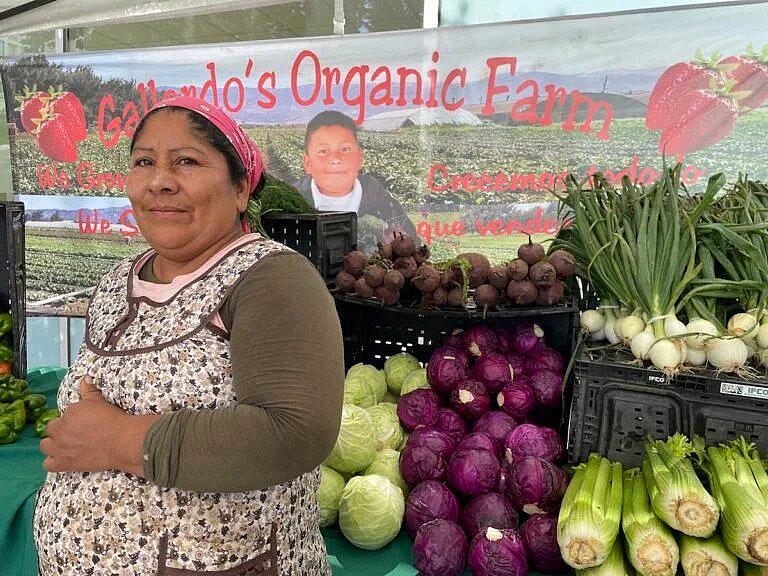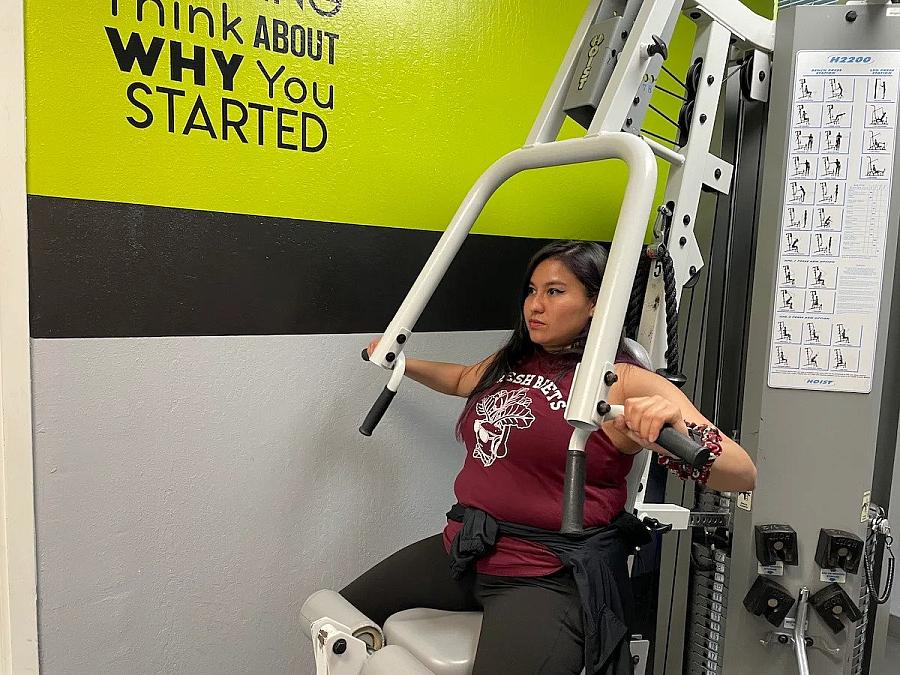A doctor’s hunt for community-based solutions to childhood obesity
This project was originally published by WHYY with support from our 2023 California Health equity Impact Fund.

A mother and her daughter pick out produce at Everyone's Harvest market in Salinas.
Courtesy of Hester Parker
Most parents are familiar with kids’ growth charts. In the clinic, parents love it when I invite them to peek over my shoulder to take a look. They track their kid’s height and weight with the same attention as checking a report card.
When a child is underweight, there’s almost universal concern. But since I started seeing pediatric patients in 2000, it’s become much more common for kids to be overweight.
One in five children in the United States is obese — that’s 15 million children. What’s more, over 4.5 million children have severe obesity. This subset of heavier children exceeded the parameters on the Centers for Disease Control and Prevention (CDC) 2020 growth charts. To help monitor the burgeoning group of children with severe obesity, the CDC created extended growth charts last year.
I’m a pediatric gastroenterologist. It used to be rare for me to see a child with fatty liver disease. It’s a condition where excess fat in the liver causes damage. Now, it’s one of the top diagnoses. While not all children with fatty liver have severe obesity, many do. In addition to fatty liver, these children may have other serious obesity-related complications. There are mental health implications too. Children who carry extra weight can experience isolation, bullying, and depression.
This year, the American Academy of Pediatrics released new guidelines for managing childhood obesity. The guidelines recommend at least 26 hours of intensive family-based health visits within a year. Although a few primary care clinicians or community organizations can provide some services, it’s a lofty goal — especially in a health system that’s overloaded.
In California, like the rest of the U.S., multidisciplinary clinics with the money and manpower to provide comprehensive obesity care are rare. They’re generally at large academic centers far away from rural communities. Even if the centers are nearby, these specialized places usually have months-long waiting lists. I investigated how underrepresented communities can find local solutions.
Treating obesity at primary care visits
Heloisa Junqueira, a pediatrician at Natividad Hospital in Salinas sees patients before they get referred to specialists like me. Doctors like Junqueira see the patients first, and they see them most often.
“The main concern is that these children are developing Type 2 diabetes and hypertension and metabolic syndrome at a very young age,” Junqueira said.

Heloisa Junqueira says limited access and high cost of healthy foods is driving her families to eat differently than before.
Christine Nguyen/For WHYY
Natividad Hospital, the major public hospital in Monterey County, serves a largely Hispanic community. “I would say over 90% of our patients are Hispanic. And of those, the vast majority are families of farmworkers,” Junqueira said.
During the COVID-19 pandemic, childhood obesity in California increased from 19% to 26%. The statistics are worse for children of color. In Monterey County, where ⅔ of the population is Latino, the rate of childhood obesity is even higher.
Junqueira says there’s been a big change in the number of children she’s seen with Type 2 diabetes or prediabetes. “I would say in the last 10 years, it’s been astonishing.”
Diabetes is just one problem. Children with severe obesity have higher rates of asthma, high blood pressure, and kidney problems. They can’t get rest because of sleep apnea. They also get arthritis and liver disease. Junqueira has seen all of this. These chronic health conditions pile on the county’s already overburdened primary care system.
So, when the American Academy of Pediatrics recommended kids with obesity get at least 26 one-hour appointments for “Intensive Health Behavior and Lifestyle Treatment,” Junqueira was glad someone finally sounded the alarm. But she finds the expectations also collide with reality.
“In a primary care visit, you have 20 minutes from beginning to end with a patient. That includes pre-charting, seeing the patient and closing the chart. You can’t really explore any diet and food issues within that time frame,” said Junqueira. “Even if they hired 50% more providers, that would still not be enough.”
Junqueira says she doesn’t have the training to prescribe weight loss medications — another intervention the new guidelines suggested. For many of her patients, a prescription for weight loss medications skips more basic steps like improving access to nutritious foods or making it safe and appealing to stay physically active. Some of the medications, like the GLP-1 agonists Ozempic, Wegovy, or Saxenda have to be taken indefinitely, since patients usually regain weight if they stop the medication, so she’s concerned about the long-term implications. Saxenda has a warning about suicidal behavior and ideation.
“More medicalization of more issues that are going to be treated with pharmaceuticals,” Junqueira said.
For her patients who truly need medications, or even surgery, the waitlist to see specialists with expertise can be months. Then families need to get to these appointments, which are usually far from home. Students would have to miss school and parents would miss work. When appointments are outside the community, patients often miss appointments or cancel at the last minute.
“In our population, [parents] work from April to November. So, trying to get those families to miss days of work to come to the clinic for problems that they don’t see as a problem? You’re setting yourself up for failure,” said Junqueira. “Because if they miss so many days of work, they get put at the end of the line, and they’re not going to be called to work again.”
Junqueira knows success means designing visits to fit working families’ lives. To spend more time with more patients, she wants to restart longer group visits, something she did before the pandemic.
“I set up group visits once a week, where we would meet with eight to 10 families. And we would talk about food choices, reading labels, portion sizes. We did it in Spanish. And I tried to do most of it in the winter when the parents would come.”
The longer group visits may be one way to come close to the 26 hours of family-based interventions the AAP recommends.
“You have time to elaborate on these issues. You have time for questions and answers. You have time for slides. You have time for hands-on experiences like having the children measure the sugar that goes into each drink.”
Junqueira also wants to improve nutrition. She says limited access to healthy foods is a driver of pediatric obesity in the county. It’s a paradox in this place that’s known as the “salad bowl” of America. The Salinas Valley produces 70% of the nation’s lettuce crops. But the farmers who work here often don’t get much of the bounty.
“These are family oriented, hard-working people.” Junqueira said. “I am very thankful for what they do. They put the food on our plates. And I don’t think they get enough recognition for that.”
About ⅔ of farmworkers in Salinas and the surrounding county are food insecure. Because families juggle paying for rent, utilities, gas, and childcare, when it’s time to buy food, they often scrimp.
“It’s a lot cheaper to buy an extra-large pizza for a family of five than buying fruits and vegetables for a family of five,” Junqueira said.
To encourage her families to buy more fruits and vegetables, Junqueira writes “FreshRx” prescriptions. It’s a “food-as-medicine” program funded by Natividad Hospital and redeemable at participating farmers markets, including Everyone’s Harvest. The market operates weekly from May to October in Natividad’s parking lot. Any child who is overweight is eligible to get a prescription. To further improve access to healthy foods, the market also accepts CalFresh debit cards, California’s version of the national Supplemental Nutrition Assistance Program (SNAP). The market also offers a Market Match program, which doubles CalFresh benefits if they are spent on fruits and vegetables.
Finding access to healthy foods
Albis Claribel Lopez has beautiful produce — strawberries, carrots, artichokes, onions, cilantro — piled high at her stand at the Natividad market. She and her husband, former fieldworkers, now run their own farm, Gallardo’s Organic Farm in Watsonville.

Albis Clarabelle Lopez says her son inspires her to improve her community’s access to healthy food.
Christine Nguyen/For WHYY
She proudly sells her produce to customers, many who work in the agriculture industry. She wants to change how her community eats.
Lopez grew up on a rancho in Chiapas, Mexico, where she ate lots of fresh foods, and rarely any sweets. But in Salinas, she says it was more difficult to eat healthfully.
She always tried to feed her family well, but when her son developed Type 1 diabetes at 8 years old, she became even more vigilant about his nutrition. She says unhealthy foods are everywhere –- even in the school meals that are free to all students. In 2022, California made breakfast and lunch available at no cost to all public and charter school children. The goal was to reduce food insecurity, and many local families depend on school nutrition programs. But Lopez says the offerings aren’t that healthy.
“My concern is about the school food is that they have a lot of … bread and sugary milk,” Lopez said in Spanish.
When I check the school menus where I live, there’s lots of starch and added sugar. Breakfast includes sweetened cereals. For lunch, there’s popcorn chicken with a mashed potato bowl. The second ingredient in the “fat free” chocolate milk is sugar. For my own patients with fatty liver, these kinds of foods can make their disease worse.
Lopez knows that wanting healthy food is one thing, but affording it is another. So, she often nudges her customers to visit the mesitas or “little tables” where they can learn about Fresh Rx and how to double their buying power with Market Match.
‘A win’ means improving kids’ lives
The Indian Health Center of Santa Clara Valley, or IHC, is in San Jose, about an hour from Salinas. Originally founded to serve urban Native Americans, the IHC is a Federally Qualified Health Center that provides comprehensive community care for low income people of all races and ethnicities. To address food insecurity, IHC partners with the local food bank to give free food in a dignified farmer’s market setting. Clients can choose the free food they want, rather than accepting whatever is given to them in a box.
IHC also has a fitness center. Kids use the gym free with a doctor’s referral. They can also attend free camps and kid-friendly classes.
Marissa Hemstreet, from Cañoncito Band of Navajos, is the fitness coordinator at the center. Before she started as an employee, Hemstreet was a teen patient at the center.
When kids and parents come to her, there’s often a lot of shame.
“We’ve had children come in here and tell us, “Hey, I want to come work with you because I’m fat,” said Hemstreet. “And for some folks they want to cry when they hear the word fat because they’re like, ‘Fat means bad. Fat means ugly. Fat means disgusting.’ When in reality, fat is just a substance, and we need fats. Fats are healthy.”
Hemstreet encourages kids and their families to reframe this loaded word. It’s because she understands weight stigma.
“I’m not super ‘cut.’ I don’t have super defined muscles,” says Hemstreet. People sometimes doubt her skills based on her appearance. “Some folks they’ll say, ‘You don’t look like this,’ or “You don’t look like that. Are you even certified?’”

Studying kinesiology motivates fitness trainer Marissa Hemstreet to help avert the childhood obesity crisis.
Christine Nguyen/For WHYY
Even some doctors have doubted her and have made her feel self-conscious about her body.
“[It’s] because of body mass index scales. I’m over my BMI for my height,” Hemstreet said.
The BMI – or body mass index – is a quick and dirty way to calculate a person’s risk for obesity. But it’s got problems. At the same weight relative to their height, some people can be healthy and others not. It depends on a lot of other factors, including gender, age, race or ethnicity, and physical activity.
“With children, I like to remind parents that BMI scales, while they do help in certain respects, they’re not the end-all be-all to assessing whether or not you’re a healthy person,” Hemstreet said.
She doesn’t dwell on a numerical weight. And she’s careful with her language.
“We do check weight, but for the kids, I only try to check weight maybe once every two weeks, because I don’t like them to see the number, and be discouraged by that after each reading. I don’t tell them, ‘Oh, this is an improvement,’ or ‘You’ve lost weight. Good job.’ I just say, ‘Thank you. Thank you for being vulnerable and standing on a scale.’”
When she gets a new child referred to her for fitness training, Hemstreet starts by addressing the family unit, not just the child.
“Children, they don’t just listen, they follow by example. So, if a parent is looking to change the lifestyle of their child, then they also have to get involved. They also have to move,” Hemstreet said.
Her ultimate goal is making a positive change in kids’ overall well-being.
“It’s not so much the weight. It might be the way the kid feels. If they’re a little bit less lethargic — that’s a win. If they feel like they can breathe normally when they’re playing with their friends — that’s a win,” said Hemstreet. “All of our wins for our kids are not weight oriented. It can be other things, like improving their life.”
Kids grow, and there’s no universal perfect body size or shape. But kids deserve to feel and be healthy in their bodies. Community partnerships that support wholesome food and active living can be a start.